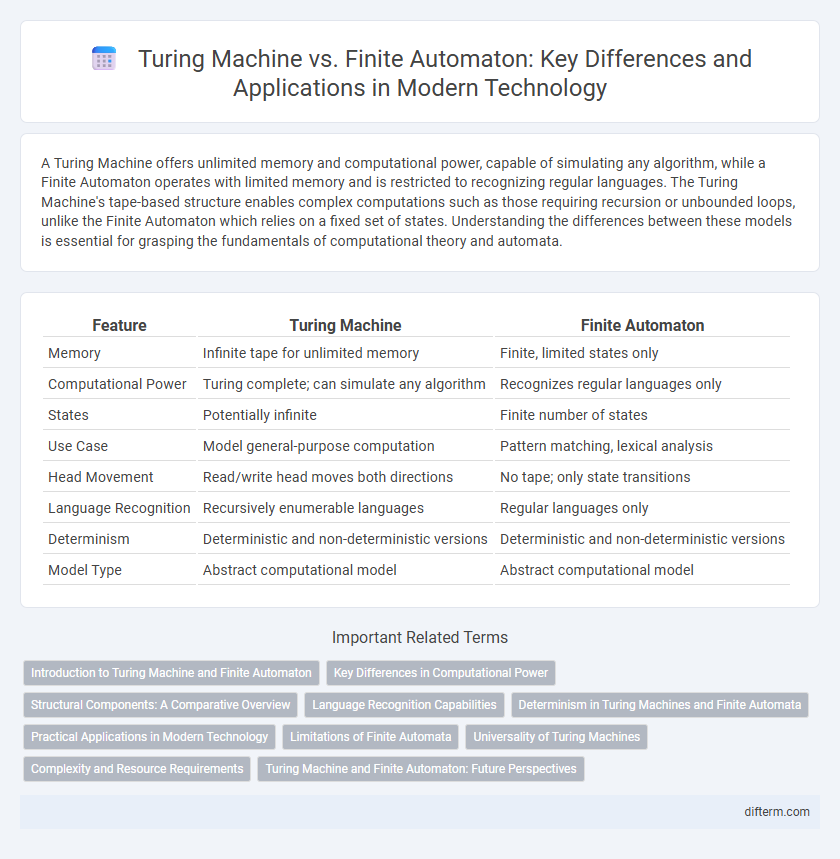A Turing Machine offers unlimited memory and computational power, capable of simulating any algorithm, while a Finite Automaton operates with limited memory and is restricted to recognizing regular languages. The Turing Machine's tape-based structure enables complex computations such as those requiring recursion or unbounded loops, unlike the Finite Automaton which relies on a fixed set of states. Understanding the differences between these models is essential for grasping the fundamentals of computational theory and automata.
Table of Comparison
| Feature | Turing Machine | Finite Automaton |
|---|---|---|
| Memory | Infinite tape for unlimited memory | Finite, limited states only |
| Computational Power | Turing complete; can simulate any algorithm | Recognizes regular languages only |
| States | Potentially infinite | Finite number of states |
| Use Case | Model general-purpose computation | Pattern matching, lexical analysis |
| Head Movement | Read/write head moves both directions | No tape; only state transitions |
| Language Recognition | Recursively enumerable languages | Regular languages only |
| Determinism | Deterministic and non-deterministic versions | Deterministic and non-deterministic versions |
| Model Type | Abstract computational model | Abstract computational model |
Introduction to Turing Machine and Finite Automaton
A Turing Machine is an abstract computational model capable of simulating any algorithm's logic through an infinite tape and a head that reads and writes symbols, enabling it to solve complex problems beyond regular languages. Finite Automaton, in contrast, is a simpler computational model with a finite set of states and transitions, primarily used to recognize patterns and regular languages within limited memory constraints. Both models form the foundation of automata theory, crucial for understanding computability and language processing in computer science.
Key Differences in Computational Power
A Turing Machine possesses a tape of infinite length that allows it to perform any computation that is algorithmically definable, representing the class of Turing-computable functions. In contrast, a Finite Automaton operates with a limited, fixed number of states and no external memory, restricting its computational power to recognizing regular languages only. Consequently, Turing Machines are strictly more powerful than Finite Automata, enabling them to solve a broader range of decision problems beyond the capabilities of automata theory.
Structural Components: A Comparative Overview
Turing Machines consist of an infinite tape, a tape head that reads and writes symbols, and a finite control unit, enabling them to perform any computation given enough time and memory. Finite Automata, in contrast, have a finite set of states, input alphabets, transition functions, and no external memory, limiting their computational power to recognizing regular languages. The key structural difference lies in Turing Machines' ability to use a read-write tape for memory manipulation versus Finite Automata's reliance solely on state transitions without auxiliary memory.
Language Recognition Capabilities
Turing machines possess the capability to recognize recursively enumerable languages, surpassing finite automata, which are limited to regular languages. This distinction highlights the Turing machine's ability to handle complex computations and infinite memory usage for language recognition tasks. Finite automata operate with a finite set of states, enabling efficient processing but restricting them to less complex language structures compared to Turing machines.
Determinism in Turing Machines and Finite Automata
Turing Machines exhibit deterministic behavior by transitioning between states based on a predefined function that determines the next state and tape action for each state-symbol pair, enabling computation beyond regular languages. Finite Automata operate deterministically when each state has exactly one transition per input symbol, simplifying recognition of regular languages but limiting computational power compared to Turing Machines. The difference in determinism reflects in their computational capabilities, with deterministic Turing Machines simulating any deterministic finite automaton but not vice versa.
Practical Applications in Modern Technology
Turing machines underpin modern computing architectures by providing the theoretical foundation for complex algorithm processing and software development, enabling applications such as operating systems and artificial intelligence. Finite automata excel in pattern recognition tasks and are widely used in lexical analysis, network protocol design, and embedded systems where state-based decision-making ensures efficient performance. Both models contribute to the optimization of computational resources and the implementation of automated processes in contemporary technology environments.
Limitations of Finite Automata
Finite automata are limited by their inability to recognize context-sensitive languages and handle arbitrarily nested structures due to their restricted memory, which only allows for a finite number of states. Unlike Turing machines that possess unlimited tape for memory, finite automata cannot perform tasks requiring counting or matching patterns beyond fixed lengths. This fundamental limitation confines finite automata to regular languages, making them unsuitable for complex computation tasks addressed by Turing machines.
Universality of Turing Machines
Turing Machines demonstrate universality by simulating any computational process given sufficient time and memory, making them capable of recognizing recursively enumerable languages. Finite Automata, in contrast, are limited to recognizing regular languages due to their finite state memory and lack of computational power to simulate arbitrary algorithms. This universality establishes Turing Machines as the foundational model for modern computation theory, highlighting their role in defining the limits of algorithmic processes.
Complexity and Resource Requirements
Turing Machines exhibit higher computational complexity and require more resources compared to Finite Automata, as they can simulate any algorithmic process with unlimited tape memory. Finite Automata operate with limited state memory and are confined to recognizing regular languages, resulting in lower resource consumption and simpler complexity. The enhanced capabilities of Turing Machines enable processing of context-sensitive and recursively enumerable languages, demanding greater time and space resources.
Turing Machine and Finite Automaton: Future Perspectives
Turing Machines, with their ability to simulate any algorithm, represent the foundation of modern computational theory and continue to influence advancements in artificial intelligence and quantum computing. Finite Automata, though limited to regular language recognition, are crucial in developing efficient parsing algorithms and hardware implementations for real-time data processing. Future perspectives emphasize hybrid models combining Turing Machines' universality with Finite Automata's efficiency to address complex computational problems in big data and autonomous systems.
Turing Machine vs Finite Automaton Infographic

 difterm.com
difterm.com